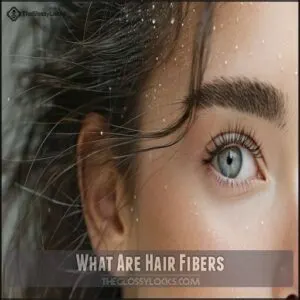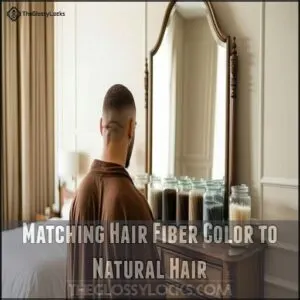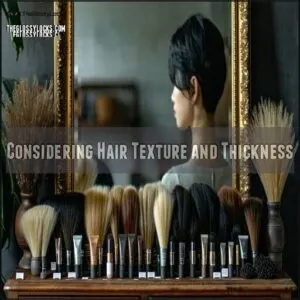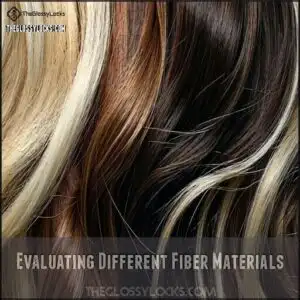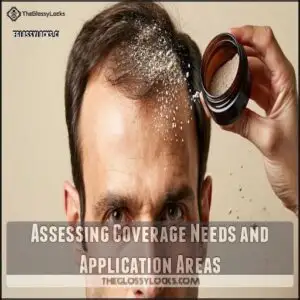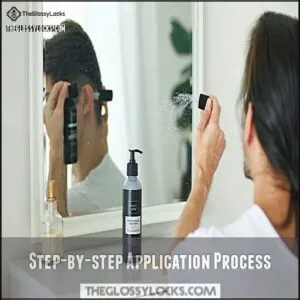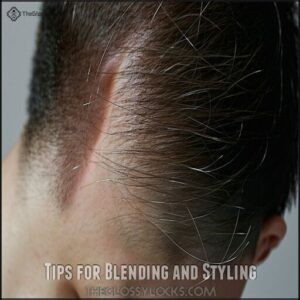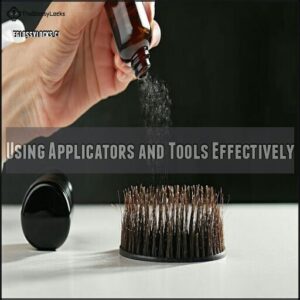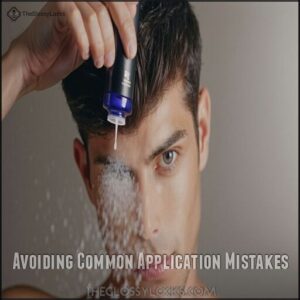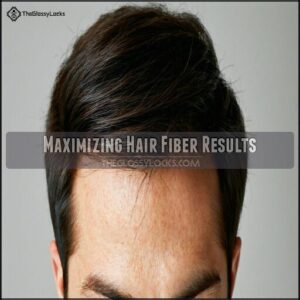This site is supported by our readers. We may earn a commission, at no cost to you, if you purchase through links.
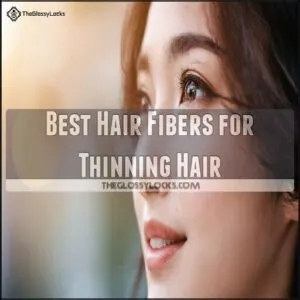 You’re looking for the best hair fibers to conceal thinning areas and bald spots.
You’re looking for the best hair fibers to conceal thinning areas and bald spots.
With so many options, it’s necessary to find the right one.
The best hair fibers are made from natural materials like keratin, are static-charged, and come in various colors to match your hair.
They’re easy to apply and create a fuller appearance, boosting your confidence.
Now, let’s explore the top options and tips to get the most out of your hair fibers, starting with the key to a perfect match.
Table Of Contents
- Key Takeaways
- What Are Hair Fibers
- Choosing Hair Fibers
- Top 10 Best Hair Fibers
- 1. Dark Brown Hairline Powder
- 2. L’Oreal Paris Root Cover Up Spray Dark Brown
- 3. Hair Building Fibers Dark Brown
- 4. Keratin Hair Thickening Fibers Medium Brown
- 5. dark brown hair thickening fibers
- 6. Hair Loss Concealer Fibers Spray
- 7. Hair Building Fibers For Thinning Hair
- 8. Natural Hair Thickening Fiber Spray
- 9. Hair Loss Concealer Building Fibers
- 10. Hair Thickening Fibers For Women
- Using Hair Fibers Effectively
- Maximizing Hair Fiber Results
- Frequently Asked Questions (FAQs)
- What are the best hair building fibers?
- What are the healthiest foods to eat for hair?
- What are the best hair loss fibers?
- Which hair fiber is best for sensitive skin?
- What are the Best Hair fibers for thinning hair?
- What are the Best Hair fibers for balding men?
- What is better than Toppik?
- What are the disadvantages of hair fiber?
- How do I choose hair fibers?
- Which fiber is best for hair?
- Conclusion
Key Takeaways
- You’ll want to choose hair fibers that match your natural hair color and texture to achieve a seamless blend and a more confident you.
- To get the most out of your hair fibers, you’ll need to apply them correctly, using the right techniques and tools, such as a hair fiber applicator or spray, to prevent common mistakes like overuse or clumping.
- You can maximize your hair fiber results by using fixing sprays or sealants to lock in your style, and protecting your fibers from wind, rain, and sweat with sweat-resistant and water-resistant products.
- When selecting the best hair fibers for your needs, you’ll need to consider factors like your hair type, the level of coverage you need, and the ease of application, and choose a product that meets those needs, such as Toppik, Caboki, or Infinity hair fibers.
What Are Hair Fibers
You’re looking for a solution to thinning hair, and hair fibers can be a great option.
Hair fibers are tiny, static-charged strands that bond to your existing hair, instantly concealing bald spots and thinning areas, and they come in various colors to match your natural hair color, making them a convenient and natural solution.
Definition and Composition of Hair Fibers
You’re looking at hair fibers, made from keratin, a key hair structure component.
Fiber materials vary, with natural hair fibers and keratin fibers being popular.
They come in different densities and contain static charge, making them cling to your hair, effectively thickening it with hair thickening fibers.
Static Electricity and Adhesion Mechanism
You’ll notice hair fibers cling to your hair due to static electricity.
Here’s how it works:
- Electrostatic charge
- Fiber bonding
- Static adhesion
- Hair attraction, creating a strong ionic binding between hair fibers and your hair.
Understanding the keratin protein structure is also essential for maintaining healthy hair, and you can learn more about it at keratin protein structure, which plays a crucial role in hair growth.
Types of Hair Fibers Available
Hair fibers are diverse, and the right type depends on your needs.
Keratin, synthetic, plant-based, cotton, and mineral fibers are common. Each has unique benefits.
Keratin fibers, for instance, are protein-based and safe for daily use. Synthetic fibers are durable and often budget-friendly.
Here’s a breakdown of the different types:
| Type | Description |
|---|---|
| Keratin | Natural, protein-based fibers derived from wool or animal sources. Safe and suitable for daily use. |
| Synthetic | Man-made fibers designed to be durable and long-lasting. Often more affordable. |
| Plant-Based | Derived from plants, offering a natural, eco-friendly option. |
| Cotton | Natural fibers from cotton plants, soft and breathable. |
| Mineral | Inorganic fibers with unique properties, often used for their durability. |
Benefits for Thinning Hair and Bald Spots
You can benefit from hair fibers for thinning hair and bald spots.
Enjoying hair regrowth and restoration with the best hair thickening fibers, which provide a natural solution for hair loss conceal, offering fiber benefits as a thinning solution for balding spots with hair fibers.
Choosing Hair Fibers
You’re looking for the best hair fibers to conceal thinning hair, and choosing the right ones can be overwhelming.
You’ll want to evaluate factors like hair color, texture, and coverage needs to find the perfect match for your hair type and style, considering thinning hair as a key factor.
Matching Hair Fiber Color to Natural Hair
When choosing hair fibers, you’ll want to match the color to your natural hair shades.
Select a fiber tone that blends with your natural hues for a seamless look.
Color matching is key to a natural appearance, so experiment with different hair fiber colors to find the best match.
To achieve the best results, consider using color matching techniques to guarantee a perfect blend with your natural hair color, ensuring a natural appearance.
Considering Hair Texture and Thickness
When selecting hair fibers, consider your hair texture and thickness to achieve a Texture Match.
Look for fibers that complement your natural hair fibers, especially in thinning areas, to achieve a seamless blend and boost hair density with the right fiber length.
For best results, it’s necessary to choose fibers that match your hair’s natural color and texture, considering factors such as Hair Thickening Fibers.
Evaluating Different Fiber Materials
You’ll find various fiber materials, including keratin, cotton, and synthetic fibers, each with pros and cons, to suit your hair type and needs.
Considering natural hair fibers, artificial hair fibers, and blended fibers is crucial for the best results with hair fiber types and ingredients like keratin fibers.
When choosing the right hair fibers, consider the importance of matching hair color to achieve a natural look.
Assessing Coverage Needs and Application Areas
Now that you’ve got a sense of the different fiber materials out there, let’s talk about evaluating your coverage needs and application areas.
Regarding hair fibers, it’s all about targeting those thinning zones and bald spots.
Here are three key points to take into account:
- Identify your hair loss patterns to determine where you need the most coverage
- Choose application techniques that work best for your hair type and thinning areas
- Use hair fibers to create a natural-looking finish that conceals bald spots and thinning zones
Top 10 Best Hair Fibers
You’re looking for the best hair fibers to conceal thinning hair, and you’ve come to the right place.
Here, you’ll find the top 10 best hair fibers that can help you achieve a fuller and more natural-looking hairline, with options that cater to different hair types and colors.
1. Dark Brown Hairline Powder
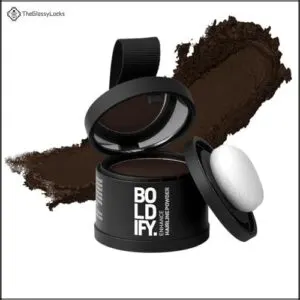
You’re looking for a reliable solution to thinning hair.
Dark Brown Hairline Powder is a great option, offering instant, undetectable hair thickening and root touch-up.
This product provides a 48-hour guarantee, with clump-proof fibers for a real hair effect.
It’s easy to apply and made with high-quality ingredients, making it a fantastic choice for achieving fuller-looking hair.
Best For: individuals experiencing thinning hair, hair loss, or root regrowth, looking for a reliable and easy-to-use solution to achieve fuller-looking hair.
- Instant, undetectable hair thickening and root touch-up
- 48-hour guarantee with clump-proof fibers for a real hair effect
- Easy to apply and made with high-quality ingredients
- May leave roots matte, requiring a shine spray
- Color matching can be challenging, requiring trial and error to find the right shade
- Some users may prefer other colors or need to try different shades to find the best match
2. L’Oreal Paris Root Cover Up Spray Dark Brown
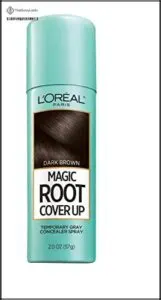
You’re considering L’Oreal Paris Root Cover Up Spray Dark Brown.
This temporary hair color spray conceals grays and lasts until the next shampoo.
It’s ammonia and peroxide-free, making it a great option for quick touch-ups between hair color appointments.
The formula is lightweight and non-sticky, providing seamless coverage without smudging.
Best For: busy individuals who need quick touch-ups between hair color appointments and want a lightweight, non-sticky formula to conceal grays.
- Some users experience overspray, which can be messy
- Not a permanent solution, requires repeated application
- May not be suitable for everyone, especially those with very light or very dark hair colors
- Covers gray roots quickly and lasts until the next shampoo
- Provides seamless coverage without smudging or sticky residue
- Ammonia and peroxide-free, making it a great option for those who want to avoid harsh chemicals
3. Hair Building Fibers Dark Brown
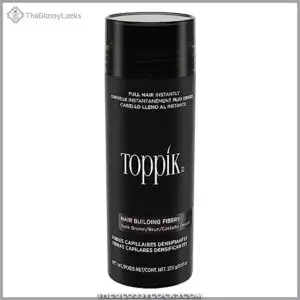
You’re checking out Hair Building Fibers Dark Brown, a great option for thinning hair.
This product instantly fills in thinning areas, conceals hair loss, and makes fine hair look thick and full.
It’s fragrance-free, long-lasting, and easy to apply, making it a fantastic choice for those seeking a natural-looking solution to hair loss.
Best For: individuals experiencing thinning hair or hair loss, particularly those looking for a quick and easy solution to conceal bald spots or thinning areas.
- Instantly fills in thinning areas and conceals hair loss
- Long-lasting results that are resistant to wind, rain, and perspiration
- Easy to apply using a spray or shake method
- Can be messy during application
- May cause increased hair fall with prolonged use
- Requires removal with cotton balls and regular hairspray
4. Keratin Hair Thickening Fibers Medium Brown
You’re looking for a reliable solution with Keratin Hair Thickening Fibers Medium Brown.
These fibers instantly fill thinning areas, making fine hair look thick and full. They’re great for root touch-ups and come in a medium brown color, suitable for various hair types.
Apply them to dry hair for a natural finish that lasts, and enjoy the benefits of Keratin Hair Thickening Fibers.
Best For: people with fine or thinning hair who want a quick and easy solution to make their hair look thicker and fuller.
- Instantly fills in thinning areas and conceals hair loss
- Great for root touch-ups between colorings
- Made from natural keratin fibers for a seamless blend and natural-looking finish
- May require hairspray for extra hold in windy conditions
- Can be pricey compared to other hair thickening solutions
- Not suitable for completely bald areas, only for thinning areas with some existing hair
5. dark brown hair thickening fibers
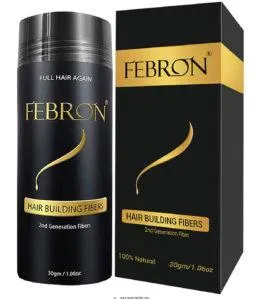
You’re exploring dark brown hair thickening fibers, a great option for enhancing your locks.
They blend seamlessly with your natural hair, creating a fuller appearance.
They’re easy to apply and come in a range of shades to match your hair color.
Simply sprinkle or spray them onto thinning areas for a quick fix, and you’re good to go, with a more confident you.
Best For: individuals with thinning hair or bald spots who want a quick and easy solution to achieve a fuller and more confident appearance.
- Easy to apply and blend with natural hair
- Comes in a range of shades to match different hair colors
- Provides a quick fix for thinning areas and bald spots
- Can be messy if not applied carefully
- May not be suitable for individuals with sensitive scalps
- Requires regular touch-ups to maintain the desired appearance
6. Hair Loss Concealer Fibers Spray
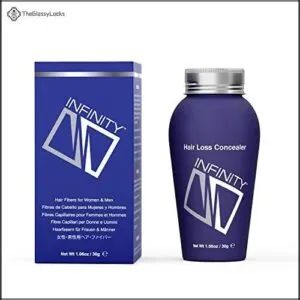
You’re in luck with Hair Loss Concealer Fibers Spray, a game-changer for thinning hair.
Made from keratin, it resists wind, rain, and sweat, lasting until your next shampoo.
Easy to apply, just shake and spray over thinning areas for instant coverage, and you’re good to go, with a natural-looking finish that boosts your confidence.
Best For: people experiencing thinning hair or bald spots, including both men and women, who want a quick and easy solution to boost their confidence.
- Made from 100% natural keratin fibers for a natural-looking finish
- Resists wind, rain, and sweat, lasting until the next shampoo
- Easy to apply, just shake and spray over thinning areas for instant coverage
- Some users may experience issues with color matching
- It may take a few tries to get used to applying it correctly
- A few users noted issues with product quality
7. Hair Building Fibers For Thinning Hair
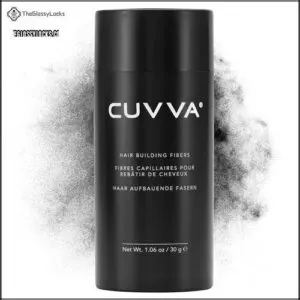
You’re looking for effective hair building fibers for thinning hair.
Hair Building Fibers For Thinning Hair is a great option, providing instant coverage and a natural look.
It’s easy to apply and comes in various colors to match your hair.
This product is perfect for those seeking a quick fix for thinning areas, and it’s a great addition to your hair care routine.
Best For: people with thinning hair who want a quick and easy solution to achieve a fuller and more natural look.
- Provides instant coverage for thinning areas
- Easy to apply and comes in various colors to match different hair shades
- Made from organic keratin protein for a natural look and feel
- May not be as effective for completely bald areas
- Can be affected by heavy rain or perspiration if not set with hairspray
- Requires regular reapplication to maintain desired coverage
8. Natural Hair Thickening Fiber Spray
You’ll love Keratherapy’s Fiber Hair Thickener, a keratin-infused spray that instantly thickens hair.
It provides dramatic density and volume, lasting until your next shampoo.
This sulfate-free, paraben-free spray is perfect for both men and women, concealing hair loss and thinning areas with ease, giving you a fuller look.
Best For: individuals experiencing hair loss or thinning, including both men and women, who want a quick and easy solution to achieve a fuller look.
- Instantly thickens hair, providing dramatic density and volume
- Sulfate-free, paraben-free, and sodium chloride-free, making it a great option for those with sensitive scalps
- Lasts until your next shampoo, making it a convenient solution for daily use
- May not be suitable for severe hair loss or balding
- Can be expensive compared to other hair thickening products on the market
- Results may vary depending on individual hair type and condition
9. Hair Loss Concealer Building Fibers
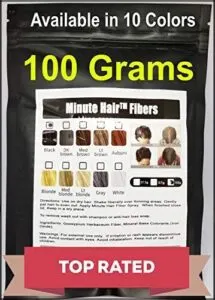
You’ll often use Hair Loss Concealer Building Fibers to cover thinning areas and bald spots.
They’re usually made from keratin protein, blending seamlessly with your natural hair.
These fibers use static electricity to create a natural bond, making your hair look thicker and fuller.
Simply shake and apply for instant results, and consider using a fixing spray for longer-lasting coverage.
Best For: people experiencing hair loss or thinning, including both men and women, who want a quick and easy solution to achieve thicker and fuller-looking hair.
- May not be suitable for everyone, especially those with certain hair textures or colors
- Can be affected by wind, rain, or sweat if not used with a fixing spray
- Some users may experience issues with color matching or the product not fully covering thinning areas
- Easy to apply and use, with instant results
- Made from keratin protein, blending seamlessly with natural hair
- Can be used with a fixing spray for longer-lasting coverage
10. Hair Thickening Fibers For Women
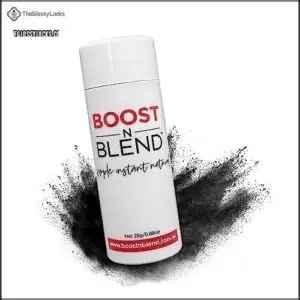
You’re in control with Hair Thickening Fibers For Women, designed to boost your confidence.
These fibers cling to your existing hair, creating a fuller look. Choose a shade that matches your natural color for a seamless blend.
Apply easily and enjoy a natural, thickening effect that lasts, giving you the hair you desire with minimal effort and maximum results, every time.
Understanding hair loss causes is essential for effective hair care and growth.
Best For: Women with thinning hair, Alopecia Areata, post-pregnancy, and post-menopause hair loss who want a natural-looking, easy-to-apply solution to boost their confidence.
- Easy to apply and use, with a natural-looking finish
- Available in various colors to match different hair types and provides long-lasting results
- Suitable for all hair types and colors, and is unscented and fragrance-free
- Some users find the product to be expensive
- A few users had negative experiences with application or color matching
- May require frequent reapplication to maintain desired results
Using Hair Fibers Effectively
You’re now ready to learn how to use hair fibers effectively to conceal thinning hair and boost your confidence.
By following a few simple steps and tips, you can achieve a natural-looking finish that lasts all day, and it’s easier than you think to get started.
Step-by-step Application Process
To apply hair fibers, follow these steps:
- Prepare fibers
- Shake well
- Spray or brush on
- Style as usual, using a hair fiber applicator and proper shaking technique for effective hair fiber application.
The steps outlined provide a clear guide on how to apply hair fibers, ensuring a proper and effective application process.
Tips for Blending and Styling
You’ll master blending and styling with practice.
| Color Matching | Fiber Texture |
|---|---|
| Exact shade | Soft fibers |
| Similar tone | Coarse fibers |
| Custom mix | Medium fibers |
Follow styling tips for a natural look, using blend techniques and hair finishing touches with your hair fiber application and hair fiber spray, and remember to use hair fiber.
Using Applicators and Tools Effectively
You’ll get the best results with the right applicator.
Choose a hair fiber applicator that suits your needs, like a spray or brush. Consider Tool Selection and Fiber Dispensing techniques for effective coverage, and don’t forget to use a fiber hold spray for a secure hold.
Effective hair fiber application often requires understanding proper fiber applicator tools.
Avoiding Common Application Mistakes
When using hair fibers, beware of common mistakes.
- Avoid overuse
- Prevent fiber clumping
- Reduce static
- Match hair color
- Use applicator correctly for a natural look and effective application tips to prevent mistakes.
Understanding proper hair gel techniques is also important for achieving the desired style.
Maximizing Hair Fiber Results
You can maximize your hair fiber results by using the right techniques and products, which will help you achieve a more natural look.
By following a few simple tips, you’ll be able to keep your hair fibers in place all day, even in windy or rainy conditions, and get the most out of your hair fiber products.
Using Fixing Sprays and Sealants
You’ll want to lock in your style with fixing sprays and sealants, which create an electrostatic bond for maximum hold.
Consider sweat-resistant and wind-resistant options to extend longevity.
Using a hair fiber spray or fiber hold spray with your hair fiber applicator for a secure finish.
Protecting Fibers From Wind, Rain, and Sweat
To protect hair fibers from wind, rain, and sweat, look for sweat-resistant, wind-resistant, and rain-resistant products with water resistance and moisture control.
Such products include hair fiber sprays with fiber fixing properties, ensuring your style stays intact with water-proof fibers.
Proper Maintenance and Removal Techniques
To keep your hair fibers looking great, focus on daily upkeep, including gentle fiber cleaning and proper storage.
Follow removal tips and reapplication methods for best hair fiber maintenance and longevity, ensuring your hair fiber application stays safe and effective, with regular cleaning and storage habits.
Understanding hair growth basics is also essential for maintaining healthy hair and maximizing the effectiveness of hair fibers, which is crucial for proper storage.
Combining Hair Fibers With Other Hair Loss Solutions
You can combine hair fibers with other hair loss solutions like Minoxidil Treatment, Laser Therapy, or Scalp Massage for enhanced results.
Exploring hair regrowth products and hair systems to tackle thinning hair, making hair fibers for hair loss a versatile tool in your hair thickening arsenal.
Frequently Asked Questions (FAQs)
What are the best hair building fibers?
You’ll find top hair building fibers from brands like Toppik, Caboki, and Infinity.
They offer natural looks, ease of use, and resistance to elements, perfect for concealing thinning hair and bald spots instantly.
What are the healthiest foods to eat for hair?
You are what you eat" applies to hair too; eat foods rich in omega-3, zinc, and vitamins to promote healthy hair growth, like salmon, spinach, and almonds, for strong locks.
What are the best hair loss fibers?
You’ll find top hair loss fibers like Toppik, Caboki, and Infinity, offering natural looks, ease of use, and resistance to elements, perfect for concealing thinning hair and bald spots instantly.
Which hair fiber is best for sensitive skin?
You’ll love FEBRON Hair Building Fibers, hypoallergenic and suitable for sensitive skin, providing a gentle, effective solution for thinning hair.
What are the Best Hair fibers for thinning hair?
You’ll want to try Toppik or Infinity hair fibers, which offer a natural look and are resistant to elements, making them great for thinning hair and daily use.
What are the Best Hair fibers for balding men?
You’ll find Caboki, Toppik, and Infinity hair fibers are great options for balding men, offering natural looks and durability against sweat and wind.
What is better than Toppik?
Imagine thicker locks, you’ll discover Caboki, a superior alternative to Toppik, offering a natural look, sweat-proof, and easy application.
Making it a great option for balding men seeking a reliable solution, with Caboki being a key factor in this decision.
What are the disadvantages of hair fiber?
You may experience fiber fallout, uneven distribution, or skin irritation as disadvantages of hair fiber, which can be frustrating and affect the overall appearance of your hair.
How do I choose hair fibers?
You’ll find your perfect match by considering hair type, color, and application method, then choosing fibers that suit your needs, like keratin or synthetic options, for a natural look.
Which fiber is best for hair?
You’ll find the best fiber for your hair by considering your hair type, desired color, and application method, then choosing a product that meets those needs, like Toppik or Caboki.
Conclusion
You’ll find the right best hair fibers to boost your confidence.
Surprisingly, 40% of men experience hair loss by age 35.
Choose the best hair fibers that match your hair color and texture, and apply them correctly for a fuller appearance, making you feel more confident with your new look using these best hair fibers.

